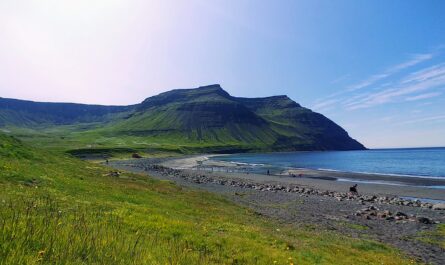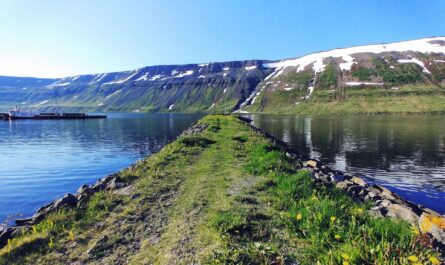Iceland is home to a shield volcano known as Skjaldbreiður. The mountain is in the southwest region of Iceland, namely in the Þingvellir National Park.
The photographs capture Skjaldbreiður from the western direction, with the lava fields in the front; it is a stunning and dramatic representation of Skjaldbreiður. It manages to convey both the strength and grandeur of the mountain, as well as the splendor of the scenery that surrounds it.

The following is some extra information regarding the mountain:
- Skjaldbreiður is 1,060 meters (3,480 feet) tall.
- Because it is a shield volcano, its profile can be described as being rather flat across its breadth.
- About 9,500 years ago, a single volcanic explosion was responsible for the formation of Skjaldbreiður.
- The Eldgja lava fields originated from the same eruption as the rest of the area.
- Skjaldbreiður is regarded as an active volcano, despite having a short historical record of eruptions, but this does not prevent it from being classified as one. Its most recent eruption occurred approximately 9,100 years ago, during the Holocene epoch, which indicates that it has been inactive for a number of centuries at this point. A number of earthquakes have been felt in the region over the course of the past week.
- Skjaldbreiður is a part of the volcanic system in Iceland, which is a result of the country’s location on the Mid-Atlantic Ridge, which is a tectonic plate boundary where the North American plate and the Eurasian plate are sliding apart. The significance of this to geology can be seen in the fact that Skjaldbreiður is a part of this system. This tectonic activity is responsible for Iceland having a large number of volcanoes and geothermal features.
- Location: Skjaldbreiður may be found in the southern portion of Iceland’s Highlands, to the northwest of Iceland’s most famous glacier, Vatnajökull.
- It is a form of volcano that has a broad, flattened shape resembling a warrior’s shield. This type of volcano is known as a shield volcano. Its effusive eruptions produce lava with a low viscosity, which means that it flows freely and spreads out across a vast region. This shape is the product of the effusive eruptions.
- Dimensions: The circumference of Skjaldbreiður is approximately 11 kilometers (6.8 miles) in length, making it one of the largest craters in Iceland. Its highest point is situated at an altitude of approximately 1,069 meters (3,507 feet) above mean sea level.
- Access: Despite the fact that Skjaldbreiður is situated in one of the most remote parts of the Highlands, hikers and mountaineers are able to reach it during the summer months. The ascent to the peak of Skjaldbreiður is not overly tough, and once you reach the top, you will be rewarded with breathtaking vistas of the surrounding area. However, because of its remote position and difficult terrain, a trip to this volcano requires extensive planning and the assistance of a knowledgeable guide. The ascent to the peak of Skjaldbreiður is not overly tough, and once you reach the top, you will be rewarded with breathtaking vistas of the surrounding area.
I really hope that you are able to better appreciate the beauty of Skjaldbreiður as a result of reading this material.


